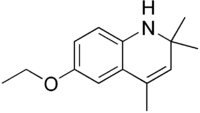Ethoxyquin
 | |
| Names | |
|---|---|
| IUPAC name
6-Ethoxy-2,2,4-trimethyl-1,2-dihydroquinoline | |
| Identifiers | |
3D model (JSmol) |
|
| ChEBI | |
| ChEMBL | |
| ChemSpider | |
| ECHA InfoCard | 100.001.887 |
| E number | E324 (antioxidants, ...) |
PubChem CID |
|
| UNII | |
| |
| |
| Properties | |
| C14H19NO | |
| Molar mass | 217.31 g·mol−1 |
| Melting point | < 25 °C (77 °F; 298 K) |
| Boiling point | 123–125 °C (253–257 °F; 396–398 K) at 2 mmHg |
Except where otherwise noted, data are given for materials in their standard state (at 25 °C [77 °F], 100 kPa). | |
| Infobox references | |
Ethoxyquin is a quinoline-based antioxidant used as a food preservative in certain countries and originally to control scald on pears after harvest (under commercial names such as "Stop-Scald").[2] It is used as a preservative in some pet foods to slow the development of rancidity of fats. Ethoxyquin is also used in some spices to prevent color loss due to oxidation of the natural carotenoid pigments.[3]
Regulation
As an antioxidant to control the browning of pears, ethoxyquin is approved in the United States[3] and in the European Union.[2]
In the United States, it is approved for use as a feed additive[4] and in food, in the spices chili powder, paprika, and ground chili.[5] Ethoxyquin is not permitted for use as food additive in Australia nor within the European Union.[6]
Ethoxyquin is allowed in the fishing industry in Norway and France as a feed stabilizer, so is commonly used in food pellets fed to farmed salmon.[7]
Ethoxyquin is used in pellets fed to chickens on chicken farms.[8]
Safety
Some speculation exists that ethoxyquin in pet foods might be responsible for multiple health problems. To date, the U.S. Food and Drug Administration has only found a verifiable connection between ethoxyquin and buildup of protoporphyrin IX in the liver, as well as elevations in liver-related enzymes in some animals, but no health consequences from these effects are known.[9] In 1997, the Center for Veterinary Medicine asked pet food manufacturers to voluntarily limit ethoxyquin levels to 75 ppm until further evidence is reported.[9] However, most pet foods that contain ethoxyquin have never exceeded this amount.[9]
Ethoxyquin has been shown to be slightly toxic to fish.[10]
2015 EFSA review
A 2015 review by the European Food Safety Authority indicated that data to assess the safety of ethoxyquin as a feed additive for target animals, or its safety for consumers and the environment are lacking.[11] The agency found one of its metabolites, ethoxyquin quinone imine, to be possibly genotoxic, and p-phenetidine, an impurity that could be present from the manufacturing process, to be possibly mutagenic.[2]
References
- ↑ Merck Index, 11th Edition, 3710
- 1 2 3 EFSA Ethoxiquin
- 1 2 "R.E.D. FACTS Ethoxyquin" (PDF). United States Environmental Protection Agency. November 2004. EPA-738-F-04-006.
- ↑ 21 C.F.R. 573.380
- ↑ 21 C.F.R. 172.140
- ↑ "COMMISSION IMPLEMENTING REGULATION (EU) 2017/962 of 7 June 2017 suspending the authorisation of ethoxyquin as a feed additive for all animal species and categories". European Union.
- ↑ Lundebye AK, Hove H, Måge A, Bohne VJ, Hamre K (2010). "Levels of synthetic antioxidants (ethoxyquin, butylated hydroxytoluene and butylated hydroxyanisole) in fish feed and commercially farmed fish". Food Addit Contam Part a Chem Anal Control Expo Risk Assess. 27 (12): 1652–7. doi:10.1080/19440049.2010.508195. PMID 20931417.
- ↑ Rubel DM, Freeman S (May 1998). "Allergic contact dermatitis to ethoxyquin in a farmer handling chicken feeds". Australasian Journal of Dermatology. 39 (2): 89–91. doi:10.1111/j.1440-0960.1998.tb01255.x. PMID 9611377.
- 1 2 3 Pet Food Labels, U.S. Food and Drug Administration
- ↑ Ethoxyquin at the PAN pesticide database
- ↑ "Ethoxyquin: EFSA safety assessment inconclusive". EFSA. November 15, 2015. Retrieved December 14, 2016.